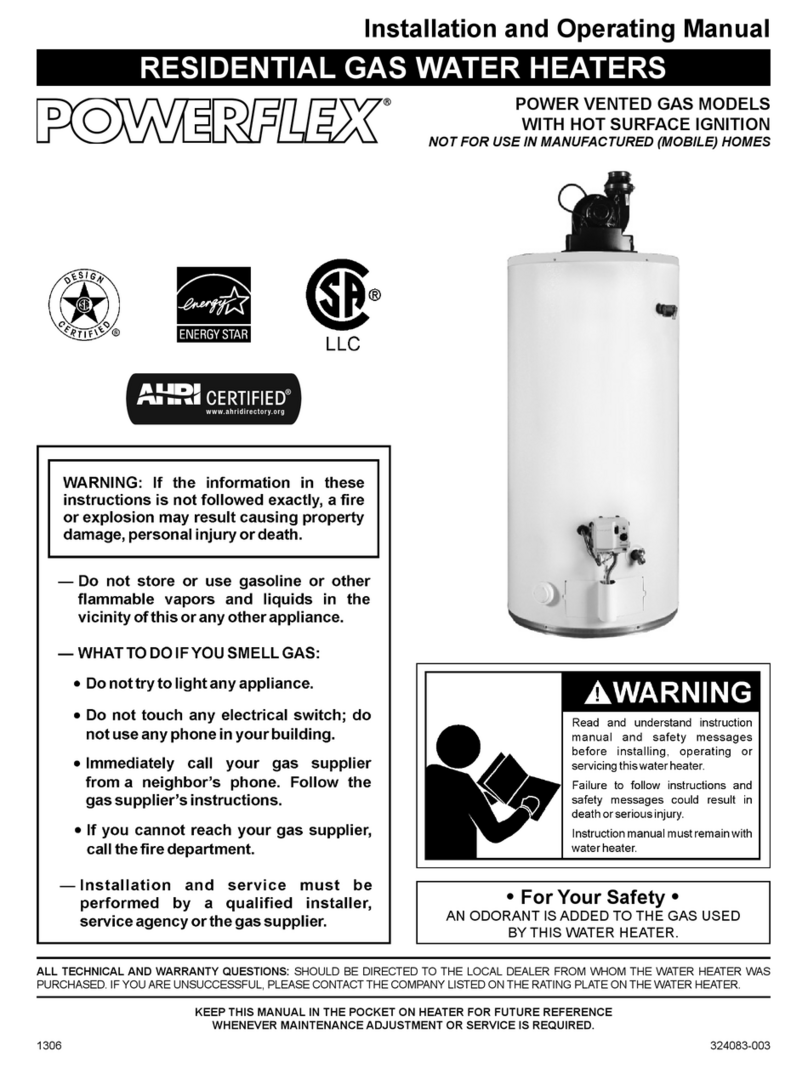
10
Vent Pipe Installation
The following guidelines should be followed when installing
the exhaust outlet piping:
• Venting should be as direct as possible with a
minimum number of pipe fittings.
• Vent diameter must not be reduced unless
specifically noted in the installation instructions.
• Support all horizontal pipe runs every four feet
and all vertical pipe runs every six feet or
according to local codes.
• Vents run through unconditioned spaces where below
freezing temperatures are expected should be prop-
erly insulated to prevent freezing. For horizontal runs,
wrap the vent pipe with self-regulating 3 or 5 watt heat
tape. The heat tape must be U.L. listed and installed
per the manufacturer’s instructions.
• Do not connect this venting system with an existing
vent or chimney.
• Do not common vent with the vent pipe of
any other water heater or appliance.
The exhaust outlet piping and termination may be installed
in one of the following type terminations:
1. Standard Horizontal
2. Vertical
All pipe, fittings, pipe cement, primers and procedures
must conform to American National Standard Institute and
Figure 8
Correct and Incorrect
Pipe Fittings
American Society for Testing and Materials (ANSI/ASTM)
standards in the United States. This water heater has been
design certified by CSA International for use with the speci-
fied (CSA) listed plastic vent pipe. Important: Do not use
vent elbows in this vent pipe installation (see figure 8).
All joints in the outlet piping
must be properly cemented.
Size and cut all piping before
cementing.
1. Cut the pipe end square
and remove all ragged
edges and burrs. Make
sure the inside of the
pipe is clean and free of
cuttings and loose dirt.
Chamfer the end and
apply primer to the fitting
and pipe.
2. Using a suitable grade of pipe cement, apply a moder-
ate, even coat inside the fitting. Apply a liberal amount
of cement to the outside of the pipe to socket depth.
NOTE: It is important to select the proper pipe cement
for the type plastic pipe being used.
3. Assemble the parts quickly while the cement is still
wet. Twist the pipe 1/4 turn during insertion and hold
for 30 seconds.
Vent Pipe Length
Size the exhaust outlet as specified in Tables 5 & 6 below.
These tables list the maximum allowable length in feet of
the exhaust outlet pipe as related to the number of required
elbows and the termination. The specified maximum
lengths are for exhaust pipe systems. Minimum pipe length
is 3 feet with one elbow.
1. Determine termination type and pipe size.
2. Determine number of elbows in exhaust pipe (Do not
include elbows in the termination.) Corresponding
number indicates the maximum length of exhaust pipe.
Vent Pipe System
This water heater must be properly vented for removal of
exhaust gases to the outside atmosphere. Correct instal-
lation of the vent pipe system is mandatory for the
safe and efficient operation of this water heater and is
an important factor in the life of the unit.
Vent pipe installation must be performed in accordance
with state and local codes, or in the absence of such, the
National Fuel Gas Code, NFPA 54, ANSI Z223.1-latest edi-
tion. Canadian installations must be performed
in accordance with CAN/CGA-B149.
Important: Check to make sure the vent pipe is not blocked
in any way. NOTE: Do not common vent this water heater
with any other appliance. Do not install in the same chase
or chimney with a metal or high-temperature plastic from
another gas or fuel burning appliance.
Vent Pipe Material
The following plastic materials may be used for both the
combustion air inlet and exhaust outlet piping subject to
state and local codes:
• 2 or 3 inch Schedule 40 PVC or ABS
• 2 or 3 inch Schedule 40 or 80 CPVC
• DWV Pipe is acceptable
NOTE: Use only solid (not foam core) piping.
Plastic pipe and fittings are available through most plumb-
ing suppliers. Always check the marking on the pipe to
make sure you are using the correct material.
Vent Pipe Connection to Blower
A 3x2” reducer is supplied with the water heater to connect
either 2” or 3” venting to the blower. Important: These
connections must be properly sealed to prevent the leak-
age of the products of combustion into the living area.
Table 5 - Maximum Allowable Length in Feet of
Exhaust Pipe - (42K BTU/Hr models only)
Pipe
Size
(in)
Number of 90° Elbows (medium or long sweep only) Termination
Options
0123456
250 45 40 35 30 25 20 Std. Horizontal
240 35 30 25 20 15 10 Vertical
3125 120 115 110 105 100 95 Std. Horizontal
3115 110 105 100 95 90 85 Vertical
Table 6 - Maximum Allowable Length in Feet of
Exhaust Pipe - (50K/60K BTU/Hr models only)
Pipe
Size
(in)
Number of 90° Elbows (medium or long sweep only) Termination
Options
0123456
2N/A Std. Horizontal
2N/A Vertical
365 60 55 50 45 40 35 Std. Horizontal
355 50 45 40 35 30 25 Vertical
Notes:
1. N/A - Not Applicable
2. The above maximum lengths are for outlet pipe systems.
3. Maximum of 6 elbows may be used. Use only medium or long
sweep elbows. See figure 8 for details.
4. Two 45° elbows are considered equivalent to one 90° elbow.
5. Minimum length is 3 foot with 1 elbow.
6. Use schedule 40 CPVC, ABS, or PVC pipe and fittings.




























